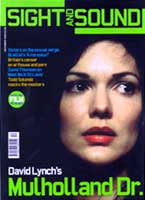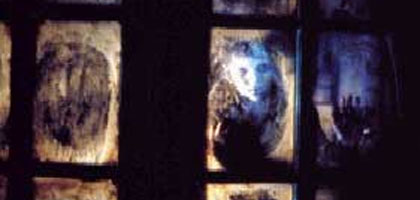
Ghost of the civil dead
Film of the Month: Devil's Backbone, The

The Devil's Backbone combines history with horror for an uncanny take on the Spanish Civil War. By Paul Julian Smith
The Devil's Backbone, director Guillermo del Toro's masterly supernatural thriller set in an orphanage haunted by the ghost of a young boy, is the latest in a distinguished line of features exploring the legacy of the Spanish Civil War from a child's point of view. It's a tradition that has long combined the domestic and the horrific. Víctor Erice's 1972 The Spirit of the Beehive (El espíritu de la colmena), for instance, had its youthful protagonist Ana - a cinematic ancestor of the orphan Carlos at the centre of this film - come face to face with Frankenstein's monster, an all-too appropriate allegory for Spanish dictator Franco.
But two aspects distinguish The Devil's Backbone from such recent UK releases as José Luis Cuerda's saccharine Butterfly's Tongue (La lengua de las mariposas) and Montxo Barrios Armendáriz's Secrets of the Heart (Los secretos del corazón). The first is its status as a Spanish-Latin American co-production, made jointly by Almodóvar's El Deseo and Mexico's Tequila Gang. Until now El Deseo has limited itself to Spanish or Basque directors who, given unprecedented artistic freedom, realised such varied fare as Alex de la Iglesia's coarse science-fiction comedy Acción mutante (1993) and Daniel Calparsoro's taut political thriller Pasajes (1996). But Backbone falls within a rapidly changing Spanish production context distinguished by a two-way transatlantic connection. Augustín Almodóvar's strategic alliance with foreign co-producers (long practised for the funding of his brother Pedro's features) parallels Spanish media giant Sogecable's successful move into English-language production with Alejandro Amenábar's The Others and mirrors Sony's recent decision to launch a Spanish-language production operation in Spain. Increasingly projects are addressed to both Spain and Latin America, territories whose cultural tastes remain diverse. In this context the expert casting of The Devil's Backbone is significant. The two leads (both schoolteachers in the orphanage) are Argentine Federico Luppi, who has frequently worked in Spain, and Spaniard Marisa Paredes, who has starred in Mexican maestro Arturo Ripstein's Deep Crimson (Profundo carmesi, 1997) and No-one Writes to the Colonel (El coronel no tiene quien le escriba, 1998).
The second intriguing feature is the record of del Toro himself. Exploiting his professional background in special effects and make-up, his first feature Cronos (1993) was a brilliant essay in body horror in which a mechanical vampire transforms a mild-mannered antique dealer (Luppi once more) into a rabid zombie. More importantly perhaps, Cronos is set in an eerily deracinated Mexico City where Argentine tangos (associated with Luppi's character) collide with Russian street signs and dialogue alternates between Spanish and English. The vampire machine, brought to the New World by a Spanish colonist, is an uncanny allegory for the mixed and warring roots of Mexican culture. Widely praised, Cronos was followed by the much cruder Mimic (1997) in which Mira Sorvino fights off giant cockroaches in the New York subway. Rescued from Hollywood by the brothers Almodóvar, how does del Toro cope with his first film made in Europe and in a period setting?
The Devil's Backbone features all the visual brilliance that once made del Toro seem destined to be the founder of Mexico's own 'cinéma du look'. The opening montage of a falling bomb, wounded child and body parts drifting in amber liquid is dazzlingly realised. Expert cinematographer Guillermo Navarro alternates the stark day-lit exteriors of the central Spanish plain with nocturnal interiors that either glow warm and brown in Velázquez-hued domestic scenes or shimmer blue and grey in the child's supernatural encounters. The digital swirl of dust and flies around ghost child Santi is executed with panache. And the accomplished visual effects are matched by a subtle sound design, in which the conflict between brutal Spaniard Jacinto (played by matinee idol Eduardo Noriega, now hardened into a convincingly repellent macho) and kindly Casares (Luppi) is played out through their choice of music: the traditional Spanish songs of Imperio Argentina (Spanish collaborator with the Nazis) or the tangos of Argentine national hero Carlos Gardel.
While del Toro reconciles European and Latin American elements in the film, he has more trouble adapting his distinctive sensibility to a historical setting. Casares' opening voiceover suggests a psychological explanation for the uncanny: 'What is a ghost? A terrible moment condemned to repeat itself over and over... a sentiment suspended in time.' And del Toro's narrative (he is one of three credited screenwriters) echoes the conflict between the two Spains played out in the Civil War itself: the scientific rationalism of the leftist schoolmaster versus the supernatural irrationalism implicitly embodied by fascism. This sophisticated approach chimes with Freud's analysis of the uncanny, in which the supernatural is defined as a displaced or repressed version of the real, but it tends to undercut the frisson of the horror genre. While del Toro can faithfully execute a suspense sequence worthy of his master Hitchcock in the scene where the boys fetch water in the dead of night, the appearances of the ghost are too prosaic to satisfy genre aficionados. This is largely because of the interference of the historical setting in the supernatural drama. At the height of the Civil War it hardly requires supernatural intuition to predict, as ghostly Santi does, that 'many of you will die.' Likewise Casares remarks to his beloved Carmen that it is they, the outnumbered and vulnerable Republicans, who are the real ghosts. If the uncanny is diagnosed too well, then surely its potency is lost?
But del Toro's dazzling way with the image pulls him and the picture through: a massive unexploded bomb stands in the centre of the children's playground (one child claims you can hear its heart beat); a mysterious clockwork frog takes the place of Cronos' vampire machine. Perhaps the eerie basement where child and torturer meet their end in a womb-like water cistern also has a particular resonance: Mexican culture is also built over ancient and violent foundations, and it's not too far-fetched to compare the film's doomed Spanish orphanage to the great baroque buildings of Mexico City. In spite of an overextended final act, then, The Devil's Backbone remains the work of a great stylist with a uniquely disturbing attraction to, and vision of, the frontier between life and death.
